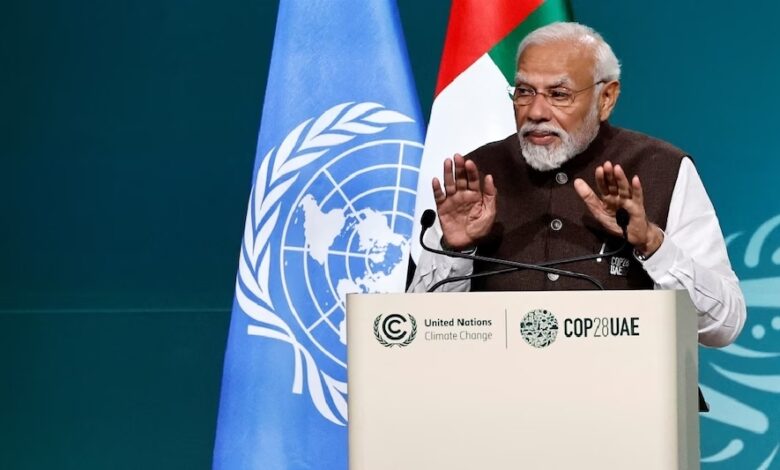Overview
During the grand commencement of the high-level segment at COP 28 in the UAE, Prime Minister Narendra Modi delivered a significant declaration. He shared his vision during the event and unveiled plans to host the 33rd Conference of the Parties of the UNFCCC (COP 33) in India in 2028.
In his opening remarks, PM Modi celebrated a noteworthy accomplishment for India, pointing out that the nation had successfully achieved its emission intensity targets 11 years ahead of the stipulated time frame.

Stressing India’s steadfast dedication, PM Modi emphasised the nation’s crucial role in worldwide efforts against climate change. He reiterated India’s unwavering commitment to the UN Framework for Climate Change, highlighting the country’s active participation. This commitment, he underlined, was the motivation behind putting forth India’s proposal to host the COP33 Summit in 2028.
As we delve into the question, has India surpassed its climate targets 11 years ahead of schedule? Let’s explore the details below.
India Surpasses Emission Intensity Target: Government Report
A recent government report reveals that India has exceeded expectations by reducing its GDP emission intensity by 33% between 2005 and 2019, achieving this milestone 11 years ahead of schedule.

Economic Growth and Emission Decoupling
Contrary to expectations, the report highlights a commendable feat – India’s GDP experienced a cumulative annual growth rate of 7%, while its emissions increased by only 4% per year during the same period. This divergence suggests a successful decoupling of economic growth from the traditionally associated rise in planet-warming greenhouse gas emissions.
Titled ‘The Third National Communication to the United Nations Framework Convention on Climate Change,‘ this all-encompassing report is set to be presented during the ongoing climate talks in Dubai. It delves into vital details about India’s greenhouse gas emissions, its vulnerability to climate change, and the steps taken to reduce emissions and adapt to the repercussions of climate change.
The report underscores the nation’s commitment to sustainable development and climate responsibility as India strides in achieving environmental milestones.
India’s Environmental Triumph: A 33% Reduction in GDP Emission Intensity
In a significant announcement, Environment Minister Bhupender Yadav revealed that India has achieved an impressive 33% reduction in GDP emission intensity between 2005 and 2019, surpassing the targeted milestone by a remarkable 11 years. Adding to this success, India has effectively established an additional carbon sink, absorbing 1.97 billion tonnes of CO2 equivalent during the same period.
Despite these notable achievements, there’s a nuanced aspect to India’s environmental landscape. The country’s total emissions, encompassing the Land Use, Land-Use Change, and Forestry sectors, have seen a rise of 4.56% compared to 2016.

Minister Yadav highlighted the importance of distinguishing between emission intensity and absolute emissions. Emission intensity measures the total greenhouse gases emitted for each unit increase in gross domestic product (GDP), providing a more nuanced perspective on environmental impact.
India’s Pledge: Ambitious Targets for a Greener Future
Environment Minister Bhupender Yadav affirmed India’s commitment to environmental sustainability, declaring, “We are well on track to achieve the target of reducing our GDP emissions intensity by 45% by 2030, compared to the 2005 level. Additionally, our goal includes the creation of an additional carbon sink of 2.5 to 3.0 billion tonnes through tree and forest cover by 2030.”
The minister also highlighted the broader context and explained that Nationally Determined Contributions (NDCs) form the foundation of any country’s action plans to curb the Earth’s average rise in temperature.

The aim is to limit it to well below two degrees Celsius and preferably to 1.5 degrees Celsius compared to pre-industrial levels (1850-1900). Scientists caution that breaching the 1.5 degrees Celsius threshold could worsen climate impacts such as heatwaves, floods, cyclones, heavy rains, melting glaciers, and subsequent sea level rise.
The third national communication disclosed sector-wise contributions to India’s emissions.
The energy sector led with a substantial 75.81% share of anthropogenic emissions, followed by agriculture (13.44%), Industrial Process and Product Use (8.41%), and waste (2.34%).
An encouraging note was the Land Use, Land-Use Change, and Forestry (LULUCF) sector, which removed 485,472 gigatonnes of carbon dioxide equivalent (GgCO2e) emissions.
Considering emissions and removals, India’s net national emissions in 2019 amounted to 2.6 billion tonnes of CO2 equivalent (26,46,556 GgCO2e).
India stands among the 26 developing countries that have submitted their national communication based on the Greenhouse Gas (GHG) inventory of 2019 or later years. In contrast, countries like China, Brazil, South Africa, and Saudi Arabia have reported their GHG inventory for different years, 2014, 2016, 2017 and 2012 respectively.
India’s Global Climate Leadership: Aiming for COP33 in 2028
Recalling India’s hosting of COP8 in New Delhi in 2002, it was a rather humble affair compared to the expansive scale it has grown into. The possibility of hosting COP33 now reflects India’s increasing influence and firm commitment to tackling global climate challenges.
Prime Minister Modi highlighted India’s distinctive position globally, with 17% of the world’s population contributing less than 4% to global carbon emissions.
In showcasing India’s environmental accomplishments, PM Modi proudly shared that the nation is among the few economies on track to meet its Nationally Determined Contributions (NDC) targets. It is noteworthy that India surpasses its emissions intensity goals 11 years ahead of the set schedule and accomplishes non-fossil fuel targets nine years ahead of time.

Peering into the future, India has set ambitious benchmarks, aiming for a 45% reduction in GDP emission intensity by 2030 compared to 2005 levels, achieving 50% cumulative electric power installed capacity from non-fossil fuel sources by 2030, and aspiring to transform into a net-zero economy by 2070.
Should India’s proposal to host COP33 in 2028 be accepted, it would mark a substantial milestone, positioning it as the next significant global gathering following this year’s G20 Summit, underlining India’s continued commitment to leading the charge against climate change.












Comments 1